Global Business Management Strategy of Tim Horton's in Singapore
32 Pages5105 Words242 Views
Added on 2023-06-10
About This Document
This report examines the global business management strategy of Tim Horton’s in Singapore. It investigates the external and internal business environmental factors that would impact the expansion of the concerned company in the region of Singapore. It also provides the entry strategy and implementation of the same.
Global Business Management Strategy of Tim Horton's in Singapore
Added on 2023-06-10
ShareRelated Documents
Running head: GLOBAL BUSINESS MANAGEMENT
Global Business Management
Name of the Student:
Name of the University:
Author Note:
Global Business Management
Name of the Student:
Name of the University:
Author Note:
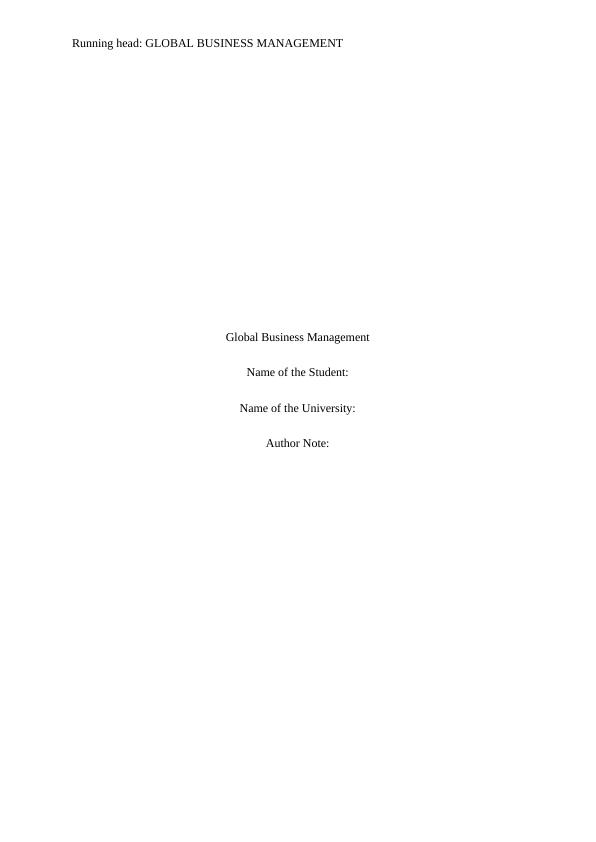
1GLOBAL BUSINESS MANAGEMENT
EXECUTIVE SUMMARY
The primary objective of this given report is to examine the global business management
strategy of the company named Tim Horton’s that is headquartered in the region of Canada.
The global sector where the business is to be expanded is determined as the country of
Singapore. In this connection, the paper is focused on investigating the external as well as the
internal business environmental factors that would impact the expansion of the concerned
company in the region of Singapore. Hereafter, the report investigates the kind of entry
strategies that is available to a business entity in order to expand its business in the global
sector. On the examination of the same, the report states that the sole proprietorship kind of
business will be the most suitable form of entry strategy for the concerned coffee chain
industry. Moreover, the report also provides the reason for the same. Finally, the report
concludes with determining the implementation of the chosen entry strategy.
EXECUTIVE SUMMARY
The primary objective of this given report is to examine the global business management
strategy of the company named Tim Horton’s that is headquartered in the region of Canada.
The global sector where the business is to be expanded is determined as the country of
Singapore. In this connection, the paper is focused on investigating the external as well as the
internal business environmental factors that would impact the expansion of the concerned
company in the region of Singapore. Hereafter, the report investigates the kind of entry
strategies that is available to a business entity in order to expand its business in the global
sector. On the examination of the same, the report states that the sole proprietorship kind of
business will be the most suitable form of entry strategy for the concerned coffee chain
industry. Moreover, the report also provides the reason for the same. Finally, the report
concludes with determining the implementation of the chosen entry strategy.
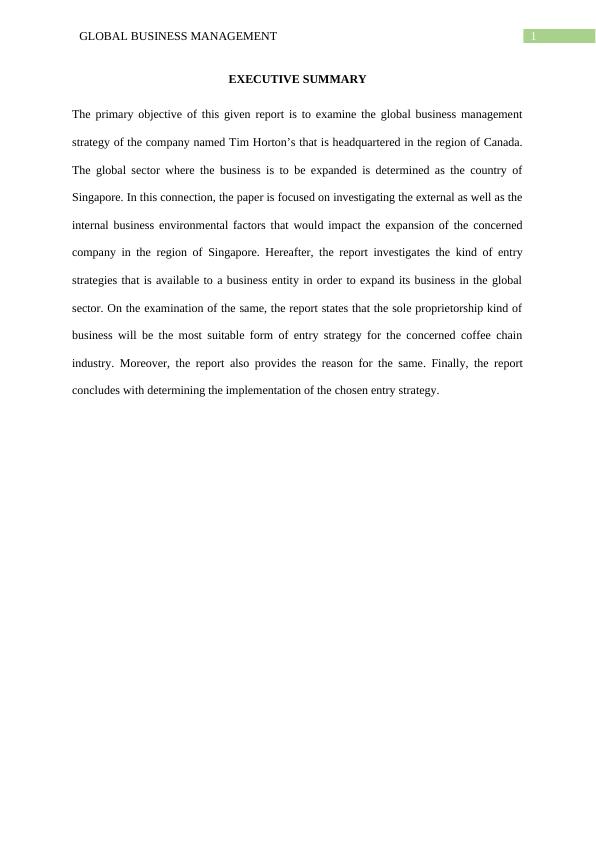
2GLOBAL BUSINESS MANAGEMENT
Table of Contents
1.0 Introduction and Company Background..............................................................................4
2.0 External Business Environment...........................................................................................4
2.1 Formal business environment..........................................................................................5
2.2 Informal business environment......................................................................................11
3.0 Internal Business Environment..........................................................................................13
3.1 Research and Development............................................................................................15
3.2 Brand Management........................................................................................................15
3.3 Capabilities.....................................................................................................................16
3.4 Core Competencies........................................................................................................16
4.0 Entry Strategy.....................................................................................................................17
5.0 Implementation of the entry strategy.................................................................................19
5.1 Timeline.........................................................................................................................19
5.2 Key Processes.................................................................................................................19
5.3 Organisational Structure.................................................................................................20
5.4 Human Resource Management......................................................................................20
6.0 Conclusion..........................................................................................................................20
7.0 References..........................................................................................................................22
8.0 Appendices.........................................................................................................................25
8.1 Appendix 1.....................................................................................................................25
Table of Contents
1.0 Introduction and Company Background..............................................................................4
2.0 External Business Environment...........................................................................................4
2.1 Formal business environment..........................................................................................5
2.2 Informal business environment......................................................................................11
3.0 Internal Business Environment..........................................................................................13
3.1 Research and Development............................................................................................15
3.2 Brand Management........................................................................................................15
3.3 Capabilities.....................................................................................................................16
3.4 Core Competencies........................................................................................................16
4.0 Entry Strategy.....................................................................................................................17
5.0 Implementation of the entry strategy.................................................................................19
5.1 Timeline.........................................................................................................................19
5.2 Key Processes.................................................................................................................19
5.3 Organisational Structure.................................................................................................20
5.4 Human Resource Management......................................................................................20
6.0 Conclusion..........................................................................................................................20
7.0 References..........................................................................................................................22
8.0 Appendices.........................................................................................................................25
8.1 Appendix 1.....................................................................................................................25

3GLOBAL BUSINESS MANAGEMENT
8.2 Appendix 2.....................................................................................................................26
8.3 Appendix 3.....................................................................................................................27
8.4 Appendix 4.....................................................................................................................28
8.5 Appendix 5.....................................................................................................................29
8.6 Appendix 6.....................................................................................................................30
8.7 Appendix 7.....................................................................................................................31
8.2 Appendix 2.....................................................................................................................26
8.3 Appendix 3.....................................................................................................................27
8.4 Appendix 4.....................................................................................................................28
8.5 Appendix 5.....................................................................................................................29
8.6 Appendix 6.....................................................................................................................30
8.7 Appendix 7.....................................................................................................................31
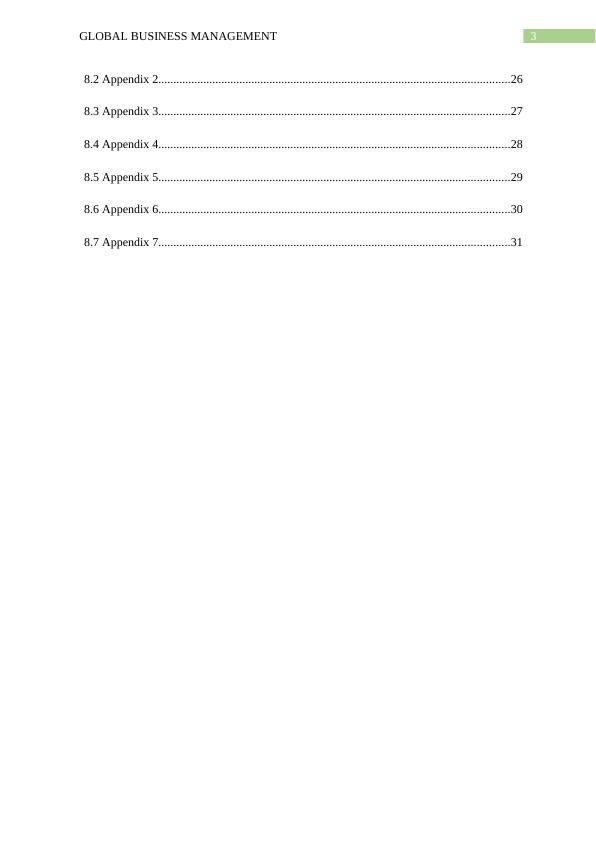
4GLOBAL BUSINESS MANAGEMENT
1.0 Introduction and Company Background
As stated by Doppelt (2017), global business is an ideology, which means that the
business entity deals with its business operations all across the world. With the synergy of
fast advancement in the technology and the expansion in international trade, every business
entity is incentivised to sell its products and services to the people all across the globe. In this
connection, the given report is focused on examining the global business prospect of the
coffee industry Tim Horton’s, Canada in the concern of establishing its business operation in
the nation of Singapore. Tim Horton’s coffee industry is determined to be a fast food chain
restaurant that specialises in the sale of coffee as well as donut items (Weatherby 2016). It is
considered to be the largest and the quickest service chain restaurant in the nation of Canada.
The same is also recorded to work with a number of 4,846 restaurants spread across 14
countries as per the statistical data presented in the year of December 31, 2018.
2.0 External Business Environment
As opined by Leonidou et al. (2017), the external business environment is determined
to consist of the outside market factors that influence the internal operations of a business
entity. With regards to this, the business entity is accountable to act according to the market
situations in order to keep its flow of operations smooth and efficient. In this connection, the
external environment of the business market of Singapore that would impact the start-up of
Tim Horton’s coffee chain is determined below.
1.0 Introduction and Company Background
As stated by Doppelt (2017), global business is an ideology, which means that the
business entity deals with its business operations all across the world. With the synergy of
fast advancement in the technology and the expansion in international trade, every business
entity is incentivised to sell its products and services to the people all across the globe. In this
connection, the given report is focused on examining the global business prospect of the
coffee industry Tim Horton’s, Canada in the concern of establishing its business operation in
the nation of Singapore. Tim Horton’s coffee industry is determined to be a fast food chain
restaurant that specialises in the sale of coffee as well as donut items (Weatherby 2016). It is
considered to be the largest and the quickest service chain restaurant in the nation of Canada.
The same is also recorded to work with a number of 4,846 restaurants spread across 14
countries as per the statistical data presented in the year of December 31, 2018.
2.0 External Business Environment
As opined by Leonidou et al. (2017), the external business environment is determined
to consist of the outside market factors that influence the internal operations of a business
entity. With regards to this, the business entity is accountable to act according to the market
situations in order to keep its flow of operations smooth and efficient. In this connection, the
external environment of the business market of Singapore that would impact the start-up of
Tim Horton’s coffee chain is determined below.
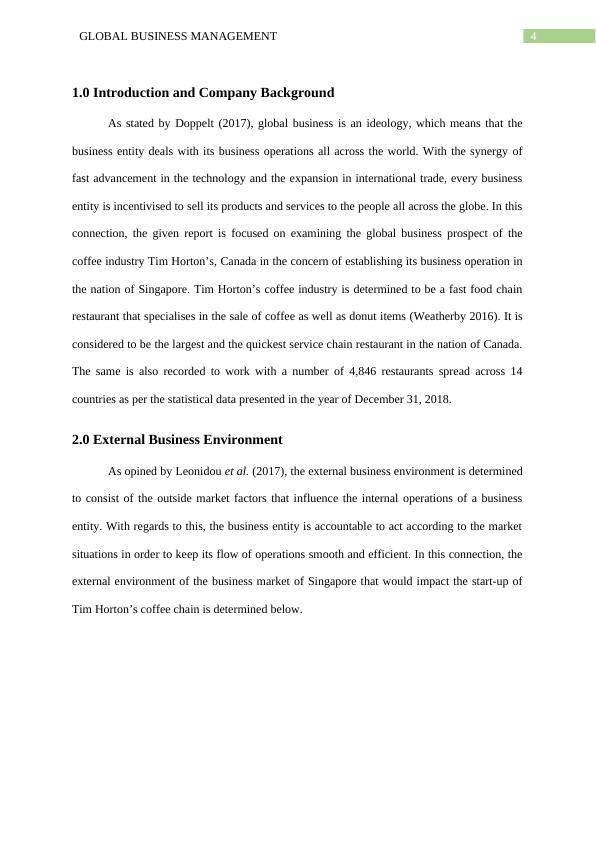
5GLOBAL BUSINESS MANAGEMENT
FORMAL BUSINESS ENVIRONMENT
Political
Political Stability
Economic
Money Supply
Taxes on International Trade
Legal
Theft Rate
Control of Corruption
INFORMAL BUSINESS ENVIRONMENT
Social
Employment Rate
Environmental
Control in the emission of CO2
gases
Table 1: Formal and Informal Institutional-based view of Singapore
2.1 Formal business environment
The formal external business environment consists of the external factors of Political,
Economic and Legal factors. The impact of these factors as concerned with the country of
Singapore on the company of Tim Horton’s is determined as below.
FORMAL BUSINESS ENVIRONMENT
Political
Political Stability
Economic
Money Supply
Taxes on International Trade
Legal
Theft Rate
Control of Corruption
INFORMAL BUSINESS ENVIRONMENT
Social
Employment Rate
Environmental
Control in the emission of CO2
gases
Table 1: Formal and Informal Institutional-based view of Singapore
2.1 Formal business environment
The formal external business environment consists of the external factors of Political,
Economic and Legal factors. The impact of these factors as concerned with the country of
Singapore on the company of Tim Horton’s is determined as below.
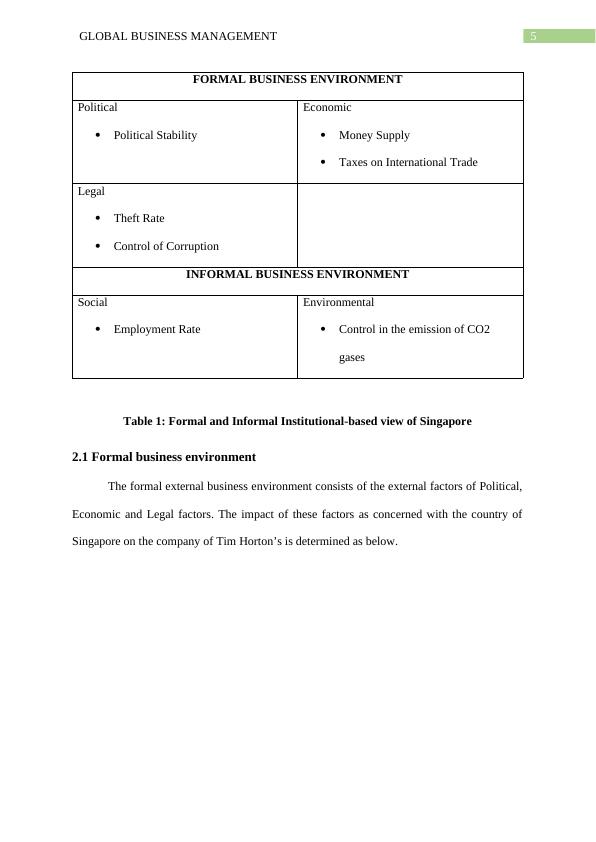
6GLOBAL BUSINESS MANAGEMENT
Political Factor
As stated by McNair (2017), the political factors are the ones which are related to the
policies of the government and its administrative practices that impact the business market of
any concerned nation. The political factors affecting the business market in the country of
Singapore is determined as its political stability. The same is specified below.
Political Stability
The political stability of a nation is described to be significant and stabilised in the
situation when the country is free of political coups as well as revolutions and civil wars
(Legg 2019). In this context, it was analysed that the political stability of Singapore has been
increasing since the fiscal year of 2014. Statistical data shows that the political stability of
Singapore, which was only at 1.18 points in the year of 2014 has increased to a significant of
1.59 points in the year of 2017. It was also examined that this rate of political stability in
Singapore has been recorded to be the highest as compared to its past years. Researches in
this connection expect that the political stability of Singapore would increase more
recognisably in the upcoming years. With regards to this, the report tends to state that Tim
Horton's coffee shop can effectively expand itself in the business market of Singapore. This is
so because, better the political stability of a country, and better the opportunities for a
business entity to run the business in a peaceful and healthy business environment. The same
is shown with the help of the given below diagram.
Political Factor
As stated by McNair (2017), the political factors are the ones which are related to the
policies of the government and its administrative practices that impact the business market of
any concerned nation. The political factors affecting the business market in the country of
Singapore is determined as its political stability. The same is specified below.
Political Stability
The political stability of a nation is described to be significant and stabilised in the
situation when the country is free of political coups as well as revolutions and civil wars
(Legg 2019). In this context, it was analysed that the political stability of Singapore has been
increasing since the fiscal year of 2014. Statistical data shows that the political stability of
Singapore, which was only at 1.18 points in the year of 2014 has increased to a significant of
1.59 points in the year of 2017. It was also examined that this rate of political stability in
Singapore has been recorded to be the highest as compared to its past years. Researches in
this connection expect that the political stability of Singapore would increase more
recognisably in the upcoming years. With regards to this, the report tends to state that Tim
Horton's coffee shop can effectively expand itself in the business market of Singapore. This is
so because, better the political stability of a country, and better the opportunities for a
business entity to run the business in a peaceful and healthy business environment. The same
is shown with the help of the given below diagram.

7GLOBAL BUSINESS MANAGEMENT
Figure 1: Showing Political Stability of Singapore
(Source: Based on Tremewan 2016)
Economic Factor
As stated by Gilpin (2016), the economic factors are the ones that affect the
economies of scale of a nation and therefore, the business entities existing in the country as
well. In this connection, the economic factors that would affect the business of Tim Horton in
Singapore are specified below.
Money Supply
The money supply is an essential factor for any country to have an active business
established in its region. If the money supplied to the country is sufficient enough, the
business organisations will be able to work with better-advanced technologies and market
conditions. Studies show that the money supply condition of Singapore has improved since
the year of 2015 till date. This piece of evidence proves that the concerned coffee chain
Figure 1: Showing Political Stability of Singapore
(Source: Based on Tremewan 2016)
Economic Factor
As stated by Gilpin (2016), the economic factors are the ones that affect the
economies of scale of a nation and therefore, the business entities existing in the country as
well. In this connection, the economic factors that would affect the business of Tim Horton in
Singapore are specified below.
Money Supply
The money supply is an essential factor for any country to have an active business
established in its region. If the money supplied to the country is sufficient enough, the
business organisations will be able to work with better-advanced technologies and market
conditions. Studies show that the money supply condition of Singapore has improved since
the year of 2015 till date. This piece of evidence proves that the concerned coffee chain

End of preview
Want to access all the pages? Upload your documents or become a member.
Related Documents
Measures to Improvise the Sales at Tim Hortonslg...
|21
|5046
|26
Foreign Market Entry Strategieslg...
|15
|2857
|13
Strategic Management of Tim Hortons : Assignmentlg...
|17
|5051
|33
Firm and Industry Analysis of Tim Hortonslg...
|13
|2989
|269
Organizational Management Analysis of Tim Horton's Restaurantlg...
|8
|1746
|159
Tim Horton’s Organizational Analysis for Performance Problemlg...
|5
|1060
|77
